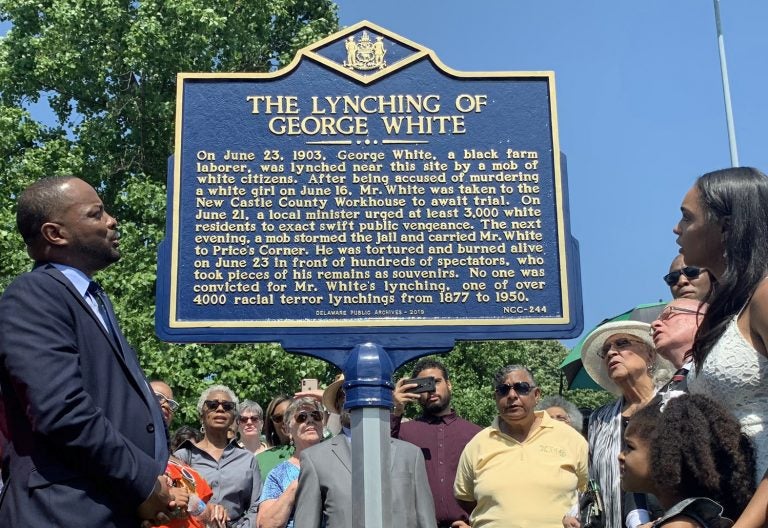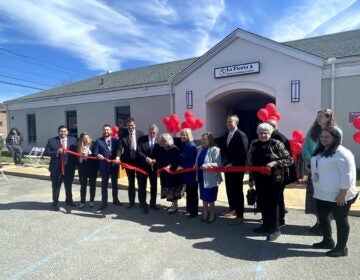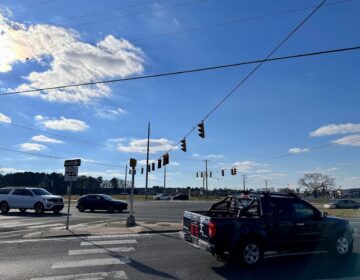Unequal Justice works to uncover Delaware’s hidden history of racial violence
A statewide effort will explore the history of racial violence in Delaware, which allowed slavery despite remaining in the Union during the Civil War.

Sen. Darius Brown, Savannah Shepherd and others read the words on The Lynching of George White Historical Marker just minutes after it was unveiled at Greenbank Park on June 23. (Scott Goss/Delaware Senate Majority Caucus)
Tiny Delaware was a miniature version of the nation in the days leading up to the Civil War. The state’s northern, more industrial part more closely resembled its Union neighbors to the north. The large farms in southern Delaware used slave labor, much like their Confederate neighbors.
Like in other slave states, lynching was one of many violent tactics employed to maintain white supremacy. A new collaboration in Delaware is working to gather information about racial violence in the state’s history.
“The focus is not solely on the history of racial violence, but also the response to those incidents. How did the community gather? How did people respond? How did it change or impact policy?” said Stephanie Lampkin, director of the Jane and Littleton Mitchell Center for African American Heritage in Wilmington. Lampkin is also interested in questions about how that violence and the response to it has changed the face of the community today.
The project is called Unequal Justice in Delaware — Rewriting the Narrative. Lampkin will work with researchers at the University of Delaware and Delaware State University to gather material on incidents that aren’t necessarily untold, but have not been thoroughly documented. Because of the state’s status as a slave state that didn’t join the Confederacy, there were fewer requirements to document racial violence in the decades following the Civil War. “It was not subject to federal laws to document or [required to] track things like lynchings,” Lampkin said.
“We definitely think there were more incidents of racial violence … lynchings specifically, and that’s what we’re working on,” said Amy Shepherd with the Delaware Social Justice Remembrance Coalition.
Shepherd’s daughter, Savannah, was the driving force behind memorializing one of those incidents: the lynching of George White, who was killed by an angry mob after being tortured and burned in June 1903. The incident happened a few miles west of Wilmington while White, who was Black, was awaiting trial after being accused of murdering a white girl a few days earlier.
But just weeks after that memorial was dedicated, someone stole the marker.
The marker was replaced in October. No one was ever charged in connection to the theft.
Similar markers have been stolen or damaged in other states. In Mississippi, a memorial marking the lynching of Emmett Till has been repeatedly shot with bullets and vandalized. But Shepherd says it’s important to keep telling these stories of racial injustice in the past, no matter the opposition. “Lean into the discomfort, lean into the difficult conversations and then maybe we can move on and find healing.”
Now Amy and Savannah Shepherd are working with the Unequal Justice in Delaware project to gather oral histories from folks in the community. “Sometimes people, we’ve learned, feel uncomfortable having official conversations about incidents from their past surrounding race,” Amy Shepherd said. “So to really get Savannah and other young people out talking to people in the community they feel a little more comfortable and ready to share.”
The project is getting initial funding from the University of Delaware with a combined $50,000 from the Office of the Provost and the Dean of the College of Arts and Sciences. Lampkin hopes their initial research will help them obtain more grant funding to continue the work.
It’s not exactly clear how their findings will be reported. The group is planning a website to show its progress. That could lead to museum exhibits or a bigger report on the history of racial violence. The work could also be translated into curriculum or lesson plans for local schools.
WHYY is your source for fact-based, in-depth journalism and information. As a nonprofit organization, we rely on financial support from readers like you. Please give today.





